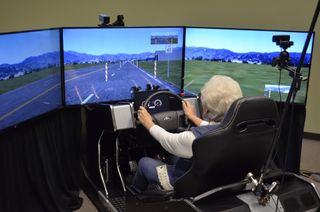Why Texting Isn't Like Other Kinds of Distracted Driving

A "sixth sense" may protect drivers when they're a bit distracted behind the wheel — but not if they're texting while driving, a new study finds.
Drivers in the study were able to stay in their lanes when researchers distracted the participants with challenging questions, the researchers said. This likely happens because the brain subconsciously corrects for any mistakes that are made, the researchers said.
But when the drivers were asked to text while behind the wheel, they tended to drift between lanes, said the study, published today (May 12) in the journal Scientific Reports. The work was led by researchers at the University of Houston and the Texas A&M Transportation Institute, and was funded in part by the Toyota Class Action Settlement Safety Research and Education Program. [Understand the 10 Most Destructive Human Behaviors]
Normally, "the driver's mind can wander, and his or her feelings may boil, but a sixth sense keeps a person safe, at least in terms of [avoiding] veering off course," Ioannis Pavlidis, a professor of computer science at the University of Houston and the lead author of the study, said in a statement.
"What makes texting so dangerous is that it wreaks havoc into this sixth sense," Pavlidis said.

In the study, 59 participants were asked to drive, in a driving simulator, down a challenging stretch of virtual highway under normal, nonstressful conditions. Then, the participants drove the same stretch under three different stressful conditions: cognitive stress, during which the driver was asked mathematical or analytical questions; emotional stress, during which the driver was asked "emotionally stirring" questions; and "sensorimotor" stress, "where the driver needs to move [his or her] eyes and one hand between the car's controls and the smartphone all the time." In this study, the sensorimotor stressor was texting.
The researchers measured every driver's biological stress response during each condition by looking at how much the driver was sweating around the nose. They also measured how many times the driver drifted into another lane.
Sign up for the Live Science daily newsletter now
Get the world’s most fascinating discoveries delivered straight to your inbox.
In all of the stressful situations, the drivers' stress levels went up, the researchers found. In addition, the increased stress levels were associated with jittery handling of the steering wheel, which could result in drivers drifting into other lanes, the study said.
However, when drivers were challenged cognitively or emotionally, they were able to correct for these "jitters" and stay in their lanes, the researchers found. It was only when the drivers' hand-eye coordination was disrupted, such as while texting, that they drifted into other lanes, the study said.
The "sixth sense," or the ability of drivers to correct their driving mistakes, may come from the part of the brain called the anterior cingulate cortex, the researchers wrote.
This part of the brain "is known to automatically intervene as an error corrector" when there is a problem, Pavlidis said. For example, if a jittery, stressed-out driver turns the steering wheel to the left, the brain responds instantaneously by steering back toward the right, he said. This ensures that the driver's steering is straight, he said. [10 Things You Didn't Know About the Brain]
But this "sixth sense," or subconscious correction, requires hand eye-coordination, the researchers said.
When drivers text at the wheel, they interrupt the necessary hand-eye coordination, and the brain no longer immediately corrects the mistakes, the researchers wrote.
Still, the results of the study don't give people license to let themselves get distracted while driving. The researchers noted that extreme levels of cognitive and emotional stress would lead to unsafe driving, and that the threshold for the amount of stress that could cause unsafe driving is unclear.
Follow Sara G. Miller on Twitter @saragmiller. Follow Live Science @livescience, Facebook & Google+. Originally published on Live Science.











